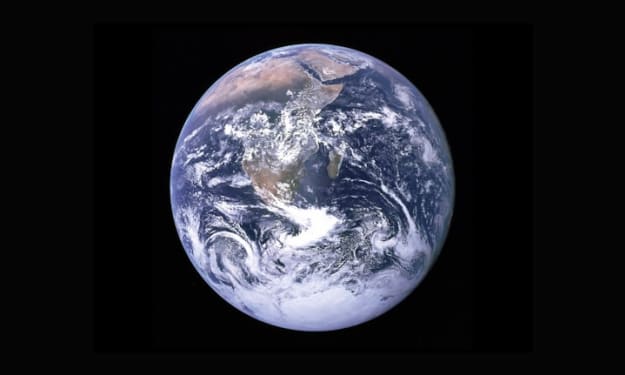Mars
Mars is the fourth planet from the Sun in the Solar System. It is often referred to by another name as the "Red Planet".

Mars, often referred to as the Red Planet due to its distinctive reddish appearance, has captivated human imagination and scientific interest for centuries. This fourth planet from the Sun offers a unique combination of Earth-like features and alien landscapes, making it a prime candidate for exploration and the search for extraterrestrial life. This essay delves into Mars's physical characteristics, its atmosphere, surface features, potential for life, and the significant scientific missions that have enhanced our understanding of this enigmatic planet.
**Mars: The Red Planet**
Mars has a diameter of about 6,779 kilometers, roughly half the size of Earth, and a mass about one-tenth that of our planet. It orbits the Sun at an average distance of 227.9 million kilometers, taking approximately 687 Earth days to complete one orbit. Mars's axial tilt of 25 degrees results in seasonal changes similar to those on Earth, albeit with more extreme temperatures. The surface temperature on Mars can range from about -125°C (-195°F) during the winter at the poles to 20°C (68°F) during the summer at the equator.
The planet's characteristic red color comes from iron oxide, or rust, which covers its surface. This iron oxide gives Mars its reddish hue and has inspired its association with war and fire in various cultures throughout history.
**Atmosphere and Weather**
Mars's atmosphere is thin, composed mainly of carbon dioxide (95.3%), with traces of nitrogen (2.7%) and argon (1.6%). This thin atmosphere provides little insulation, contributing to the planet's wide temperature variations. The atmospheric pressure on Mars is less than 1% of Earth's, making it inhospitable to liquid water under normal conditions.
Despite its thin atmosphere, Mars experiences weather phenomena, including dust storms that can cover the entire planet. These storms are driven by the solar heating of the surface, which causes air currents that lift dust particles into the atmosphere. Mars also has clouds, frost, and seasonal variations in its polar ice caps, which are composed of both water and carbon dioxide ice.
**Surface Features**
Mars's surface is a diverse landscape of volcanoes, valleys, deserts, and polar ice caps. The planet boasts the largest volcano in the solar system, Olympus Mons, which stands about 22 kilometers high and spans 600 kilometers in diameter. Another notable feature is Valles Marineris, a vast canyon system stretching over 4,000 kilometers and reaching depths of up to 7 kilometers. These geological features suggest a history of significant volcanic and tectonic activity.
Mars also has evidence of ancient river valleys, lake beds, and minerals that form in the presence of water, indicating that liquid water once flowed on its surface. The presence of water-related features has fueled speculation about the planet's potential to have supported life in the past.
**Potential for Life**
The search for life on Mars focuses on understanding its past and present habitability. While the planet's current conditions are harsh, with low temperatures, high radiation levels, and a thin atmosphere, scientists believe that Mars may have had a more Earth-like environment billions of years ago. Evidence of ancient water flows, coupled with the discovery of organic molecules by missions like NASA's Curiosity rover, suggests that Mars had the necessary ingredients for life.
Astrobiologists are particularly interested in regions where liquid water might exist today, such as underground aquifers or transient surface water in the form of brines. The detection of methane in Mars's atmosphere, albeit in varying quantities, also raises intriguing questions, as methane can be produced by both geological processes and microbial life.
**Scientific Missions and Discoveries**
The exploration of Mars has been a priority for space agencies worldwide. The Soviet Union's Mars program, NASA's Viking missions in the 1970s, and more recent missions like the Mars rovers Spirit, Opportunity, Curiosity, and Perseverance have all contributed to our understanding of the Red Planet. These missions have provided detailed images, analyzed soil and rock samples, and studied the planet's atmosphere and climate.
NASA's Perseverance rover, which landed in February 2021, is equipped with advanced scientific instruments to search for signs of past life and collect samples for future return to Earth. The rover is exploring Jezero Crater, an ancient lakebed, to study its geology and search for biosignatures.
In addition to NASA, other space agencies, including the European Space Agency (ESA) with its ExoMars program and China's Tianwen-1 mission, have joined the quest to explore Mars. These missions aim to map the planet's surface, analyze its composition, and search for evidence of past or present life.
**Conclusion**
Mars, with its intriguing blend of familiar and alien features, continues to be a focal point of planetary science and exploration. Its potential to have harbored life in the past, coupled with its challenging yet tantalizing environment, makes it a prime target for future missions. As we continue to explore Mars, we deepen our understanding of the Red Planet, the history of our solar system, and the potential for life beyond Earth. The ongoing and future missions to Mars promise to unveil new discoveries and bring us closer to answering the age-old question of whether we are alone in the universe.
About the Creator
Enjoyed the story? Support the Creator.
Subscribe for free to receive all their stories in your feed. You could also pledge your support or give them a one-off tip, letting them know you appreciate their work.






Comments (1)
Hehe, lovely reading.